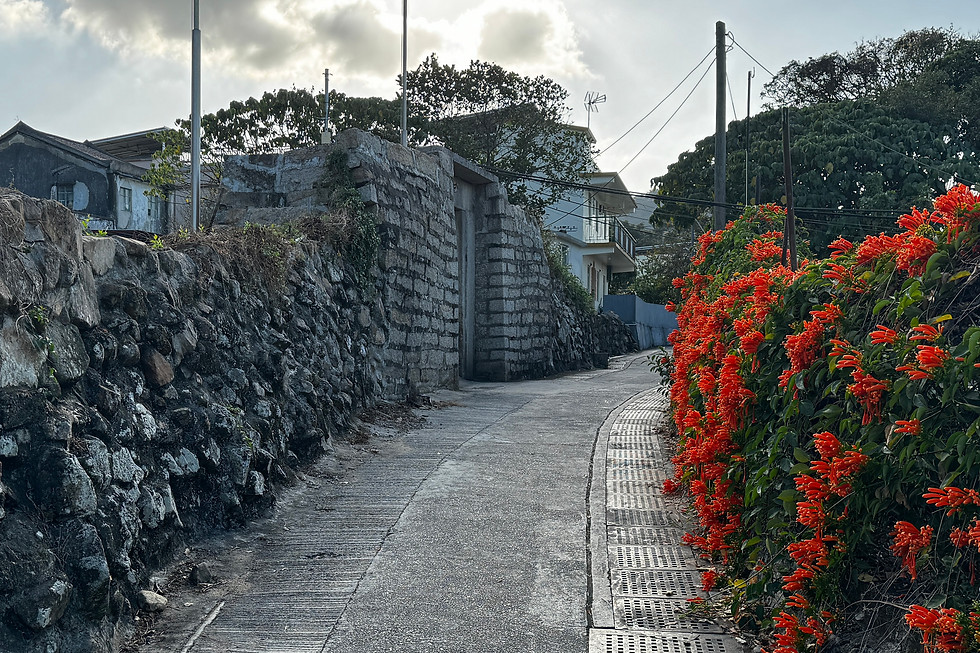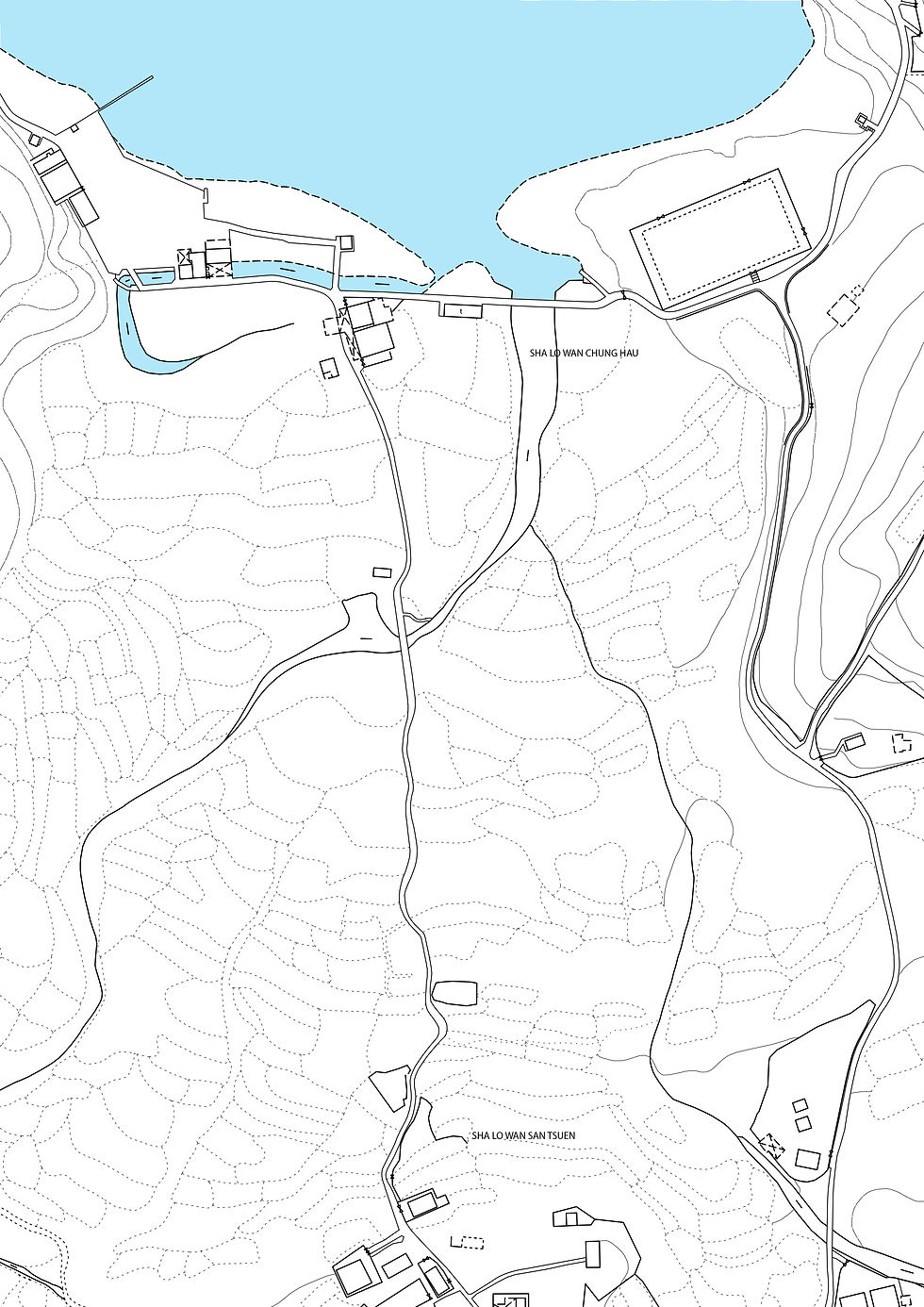Sha Lo Wan is an old Hakka village along the middle section of the Tung-O Trail. The village is nestled under the mountains and faces north, fronting the sea. According to the 1970s survey, the village layout is organized with five rows of houses in an orderly and regular manner. Most of the buildings are gable-wall structures with purlin-supported roofs. The village’s preserving condition is to be discussed, with only a section of the old village wall, gateways, and a stone altar at the corner surviving in the north, reflecting the characteristics of the original Hakka walled villages. Internal residential houses, ancestral temples, schools, and other buildings have been rebuilt or even abandoned.
沙螺灣為東澳古道中段沿線的、舊有客家村落。村落選址背山濱海,整體朝向向北。按照1970s測繪資料,村落肌理大致可看做五排村屋,規整有序。建築多為檁條托頂的硬山建築。聚落和村屋保存狀況一般,僅北側殘存一段舊村圍墻、門洞、和轉角處的石神壇,可以體現舊日客家圍的特色。內部民居、宗祠、學校等建築,或被重建或甚至廢棄。

重點建築群及景觀 Key buildings and Landscape


此遺跡據推測建於清朝中期,為一處三級歷史建築。這片曾經是客家圍村的圍牆,現今僅剩下一段基座和狀態良好的門框。該門框由麻石搭建,至今仍保留著過�往用以安裝木桿的圓形孔洞。
Relic structure, with estimated history dating back to mid-Qing dynasty, grade-3 historical building. This is the wall that surrounded the Hakka walled village in the past, and now only a section of the bottom part remains, along with well-preserved door frame made of granite and still with circular holes holding wooden poles in the past.
舊門樓及圍墻 Gatehouse and Wall
Due to the increasing number of students in Sha Lo Wan, villagers applied to the government to build this primary school. Many villagers in the village are graduates of this school. Back then, English teachers would come to teach three to four days a week. After the school closed, the building was used for wedding ceremonies and served as a dormitory for Hong Kong college student volunteers in 1966.
沙螺灣學校 Sha Lo Wan School
因為沙螺灣學生人數增加,所以村民向政府申請並於1958年新建了這所小學。現在村裡有很多學生都曾經在那裡讀書。曾經一週會有一半的時間有英文老師來教學。後來學校停辦之後,曾用於舉辦婚禮,也在1966年「香港大專」學生義工時作為宿舍使用。
The building serves as the ancestral hall for the clan in the settlement, while it was reconstructed as a total modern cement structure. The spatial relationship of the building within the settlement has certain cultural and research values. In fact, not just Li’s ancestral hall, most ancestral halls in Sha Lo Wan discarded the original form and only succeeded the tradition in terms of buildings’ functions.
文氏宗祠 Man's Ancestral Hall
建築在聚落中,承擔家族宗祠功能,但是其形式,經過近代翻修重建,已經完全為現代水泥建築。其建築在聚落中的空間關係,具有一定的文化、研究價值。實際上沙螺灣現有宗祠,基本都儘在功能上延續舊時的客家圍村傳統。



李氏宗祠 Li's Ancestral Hall
建築在聚落中,承擔家族宗祠功能,但是其形式,經過近代翻修重建,已經完全為現代水泥建築。其建築在聚落中的空間關係,具有一定的文化、研究價值。實際上沙螺灣現有宗祠,基本都儘在功能上延續舊時的客家圍村傳統。
The building serves as the ancestral hall for the clan in the settlement, while it was reconstructed as a total modern cement structure. The spatial relationship of the building within the settlement has certain cultural and research values. In fact, not just Li’s ancestral hall, most ancestral halls in Sha Lo Wan discarded the original form and only succeeded the tradition in terms of buildings’ functions.
An altar was estimated to be built in the mid-Qing dynasty. It is also built of stone and located at the edge of the old wall. The altar is situated on a platform, with several layers of steps on the side. It’s a structure for villagers’ deities worship.
沙螺灣神壇(城牆附近)Sha Lo Wan Village Altar (Near Gatehouse and Wall)
推測建於清中期的神壇。在��舊圍墻邊緣,同樣為石砌。神壇設於平台上,側接數層台階。圍村時期,用於村民拜神需求。


沙螺灣村公所,把港古廟及天后廟 平面圖


這座古廟北面臨海,由三間殿堂組成(一連三楹),其中間殿堂是把港古廟(洪聖古廟),主祀的是把港大王,一位擁有罕見尊號的神祇。廟內一大亮點是一口巨大的鐘,其鑄造年份可追溯至清乾隆三十九年(1774年),為我們提供了近二百年的歷史見證。通過對廟中碑文的研究,我們得知這座廟宇在清咸豐二年(1852年)經歷了一次重要的修繕,至今已逾一百七十年。而在其左側,是一座相對較小的天后宮,而右側則特別地沒有設置外門,呈現出獨特的建築布局。
沙螺灣舊村並未與把港古廟相連。舊村位於把港古廟的南邊,有兩條小路分別從村的東側和西側可到達把港古廟。
This ancient temple, facing the sea to the north, comprises three halls (arranged in a row). The central hall is the Pak Kong Ancient Temple (also known as Hung Shing Ancient Temple), primarily dedicated to Pak Kong Tai Wong, a deity with a rare title. A major feature inside the temple is a large bell, cast in the 39th year of the Qing Dynasty's Qianlong era (1774), providing nearly two hundred years of historical evidence. Studies of the temple's inscriptions reveal that it underwent significant renovation in the second year of the Xianfeng era (1852), over one hundred and seventy years ago. To its left is the relatively smaller Tin Hau Temple, while the right side is unique in not having an external gate, offering a distinctive architectural layout.
Sha Lo Wan Old Village is not directly connected to Pak Kong Ancient Temple. The old village is located to the south of the temple, with two small paths from the east and west sides of the village leading to Pak Kong Ancient Temple.
把港古廟 Pa Kong Temple
The Tin Hau Temple in Sha Lo Wan, built in 1919, is dedicated to Mazu. Legend has it that Mazu, invited from Nantou, Taiwan, for a festival, couldn't be returned due to stormy weather each time they tried, leading to the decision to have Mazu permanently protect the village. Over time, the temple suffered from weather and termite damage. In 2000, a major reconstruction was assisted by the Islands District Office. The temple's front plaque and couplets reflect the spirit of traditional culture.
天后宮 Tin Hau Temple
沙螺灣天后宮於1919年建立,主要供奉媽祖。傳說起因於台灣南投請來的媽祖在當地醮會期間,每當企圖送回便引起風浪,因此決定讓媽祖長駐護村。由於年代久遠,天后宮曾遭受風雨和白蟻侵蝕,2000年經過大規模重建。廟前的門額和對聯顯示傳統文化精神。

The Fuk Tak Shrine, also known as the Earth God Temple, or Pak Kung Shrine, is a place where people worship Fuk Tak Yeung, also known as the Earth God. The Earth God, also referred to as Fuk Tak Ching Shen or "Pak Kung" in the Teochew dialect. It is a local administrative deity responsible for ensuring peace and prosperity in villages and for blessing agricultural harvests. Pak Kung temples dedicated to Fuk Tak Yeung can be found in various neighborhoods, at the ends of streets, and near markets in every village.
This Fuk Tak Shrine located in Sha Lo Wan is not connected to others but is situated at the western side, at the junction of a small path.
福德祠 Fook Tak Temple
福德祠,又稱土地廟、土地公廟或伯公祠,是民間供奉福德老爺,也就是土地公的地方。土地公又称福德正神,即潮汕人口中的“伯公”,是保护乡里安定,保佑农业收成的地方行政神。各乡各里街头巷尾市场前后都会有供奉福德老爷的伯公庙。
這座位於沙螺灣的福德祠則並未與其相連,而是位於西邊小徑路口。

Sha Lo Wan, located near the sea, features a few village houses, but the coastal area is predominantly occupied by community buildings such as the village office, Pak Kong Ancient Temple, Tin Hau Temple, and the Fuk Tak Shrine. There's a large open space in front of these buildings, serving as a communal area for village gatherings. This space is utilized for traditional events like the Tai Ping Qing Jiao festival, communal Poon Choi feasts, or setting up tents for Cantonese opera performances, playing a vital role in maintaining and celebrating the community's cultural heritage.
古廟前廣場空地The Open Space before the Temple
沙螺灣的海邊區域有少量村屋,而海岸線附近主要是村公所、把港古廟、天后宮及福德祠等公共建築。這些建築前有一片寬敞的空地,用作村民聚集之地。這個空地用於舉行傳統活動,如太平清礁慶典、共享盆菜宴或搭建戲棚演出粵劇,對於保持和慶祝社區文化遺產扮演著重要角色。




